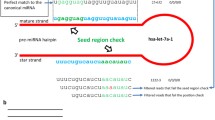Abstract
3′ addition events in miRNAs are widely detected and may contribute to miRNA stability, but little is known about details of the events in miRNA gene clusters and families. Here, we performed a comprehensive analysis of isomiR expression patterns and 3′ additions in miRNA gene clusters and families by analyzing high-throughput sequencing dataset. According to dominant modified isomiRs, miRNA members in many miRNA gene clusters and families showed the same 3′ additional non-template nucleotides. Although clustered miRNAs and homologous miRNAs had consistent or inconsistent expression levels, we found many of them showed consistent expression patterns at isomiR levels. These findings revealed similar processing mechanism and 3′ modification event of miRNAs in gene clusters and families through miRNA maturation process. The consistent maturation mechanism may contribute to co-regulate biological processes, and may originate from ancestral miRNA genes through complex duplication history.



Similar content being viewed by others
References
Kim VN, Han J, Siomi MC (2009) Biogenesis of small RNAs in animals. Natl Rev Mol Cell Biol 10:126–139
Kuchenbauer F, Morin RD, Argiropoulos B, Petriv OI, Griffith M et al (2008) In-depth characterization of the microRNA transcriptome in a leukemia progression model. Genome Res 18:1787–1797
Morin RD, O’Connor MD, Griffith M, Kuchenbauer F, Delaney A et al (2008) Application of massively parallel sequencing to microRNA profiling and discovery in human embryonic stem cells. Genome Res 18:610–621
Ruby JG, Jan C, Player C, Axtell MJ, Lee W et al (2006) Large-scale sequencing reveals 21U-RNAs and additional microRNAs and endogenous siRNAs in C-elegans. Cell 127:1193–1207
Guo L, Yang Q, Lu JF, Li HL, Ge QY et al (2011) A comprehensive survey of miRNA repertoire and 3′ addition events in the placentas of patients with pre-eclampsia from high-throughput sequencing. PLoS One 6:e21072
Azuma-Mukai A, Oguri H, Mituyama T, Qian ZR, Asai K et al (2008) Characterization of endogenous human Argonautes and their miRNA partners in RNA silencing. Proc Natl Acad Sci USA 105:7964–7969
Burroughs AM, Ando Y, de Hoon MJ, Tomaru Y, Nishibu T et al (2010) A comprehensive survey of 3′ animal miRNA modification events and a possible role for 3′ adenylation in modulating miRNA targeting effectiveness. Genome Res 20:1398–1410
Ebhardt HA, Tsang HH, Dai DC, Liu YF, Bostan B et al (2009) Meta-analysis of small RNA-sequencing errors reveals ubiquitous post-transcriptional RNA modifications. Nucleic Acids Res 37:2461–2470
Fernandez-Valverde SL, Taft RJ, Mattick JS (2010) Dynamic isomiR regulation in Drosophila development. RNA 16:1881–1888
Lee LW, Zhang S, Etheridge A, Ma L, Martin D et al (2010) Complexity of the microRNA repertoire revealed by next generation sequencing. RNA 16:2170–2180
Li JJ, Yang ZY, Yu B, Liu J, Chen XM (2005) Methylation protects miRNAs and siRNAs from a 3′-end uridylation activity in Arabildopsis. Curr Biol 15:1501–1507
Katoh T, Sakaguchi Y, Miyauchi K, Suzuki T, Kashiwabara S et al (2009) Selective stabilization of mammalian microRNAs by 3′ adenylation mediated by the cytoplasmic poly(A) polymerase GLD-2. Genes Dev 23:433–438
Aravin AA, Lagos-Quintana M, Yalcin A, Zavolan M, Marks D et al (2003) The small RNA profile during Drosophila melanogaster development. Dev Cell 5:337–350
Hertel J, Lindemeyer M, Missal K, Fried C, Tanzer A et al (2006) The expansion of the metazoan microRNA repertoire. BMC Genomics 7:25
Zhang YF, Zhang R, Su B (2009) Diversity and evolution of MicroRNA gene clusters. SCI China C 52:261–266
Guo L, Lu Z (2010) Global expression analysis of miRNA gene cluster and family based on isomiRs from deep sequencing data. Comput Biol Chem 34:165–171
Baskerville S, Bartel DP (2005) Microarray profiling of microRNAs reveals frequent coexpression with neighboring miRNAs and host genes. RNA 11:241–247
Yu J, Wang F, Yang GH, Wang FL, Ma YN et al (2006) Human microRNA clusters: genomic organization and expression profile in leukemia cell lines. Biochem Biophys Res Commun 349:59–68
Viswanathan SR, Mermel CH, Lu J, Lu CW, Golub TR et al (2009) microRNA expression during trophectoderm specification. PLoS One 4:e6143
Griffiths-Jones S, Saini HK, van Dongen S, Enright AJ (2008) miRBase: tools for microRNA genomics. Nucleic Acids Res 36:D154–D158
Langmead B, Trapnell C, Pop M, Salzberg SL (2009) Ultrafast and memory-efficient alignment of short DNA sequences to the human genome. Genome Biol 10:212
de Hoon MJL, Taft RJ, Hashimoto T, Kanamori-Katayama M, Kawaji H et al (2010) Cross-mapping and the identification of editing sites in mature microRNAs in high-throughput sequencing libraries. Genome Res 20:257–264
Guo, L, H Li, J Lu, Q Yang, Q Ge et al (2011) Tracking miRNA precursor metabolic products and processing sites through completely analyzing high-throughput sequencing data. Mol Biol Rep 39:2031–2038
Acknowledgments
The work was supported by the project 30871393 from National Natural Science Foundation of China and funded by Tsinghua National Laboratory for Information Science and Technology (TNList) Cross-discipline Foundation. The work was also supported by a research Grant from the Innovation Project for Graduate Student of Jiangsu Province (No. CX10B_081Z), the Scientific Research Foundation of Graduate School of Southeast University, Science and Technology Project in Nanjing (201001095) and Pre-Research Project for National Natural Science Foundation supported by Southeast University (KJ2010442).
Author information
Authors and Affiliations
Corresponding authors
Additional information
Li Guo, Hailing Li, and Tingming Liang contributed equally to this work.
Electronic supplementary material
Below is the link to the electronic supplementary material.
11033_2012_1493_MOESM1_ESM.tif
Fig. S1 The contribution of cross-mapping between homologous miRNAs. The three isomiRs can simultaneously map to hsa-miR-23a and hsa-miR-23b. (TIFF 34 kb)
Rights and permissions
About this article
Cite this article
Guo, L., Li, H., Liang, T. et al. Consistent isomiR expression patterns and 3′ addition events in miRNA gene clusters and families implicate functional and evolutionary relationships. Mol Biol Rep 39, 6699–6706 (2012). https://doi.org/10.1007/s11033-012-1493-3
Received:
Accepted:
Published:
Issue Date:
DOI: https://doi.org/10.1007/s11033-012-1493-3




